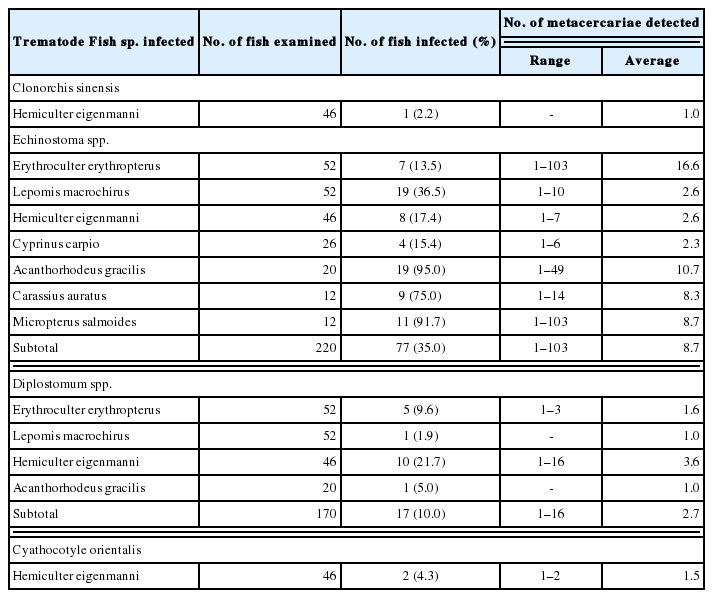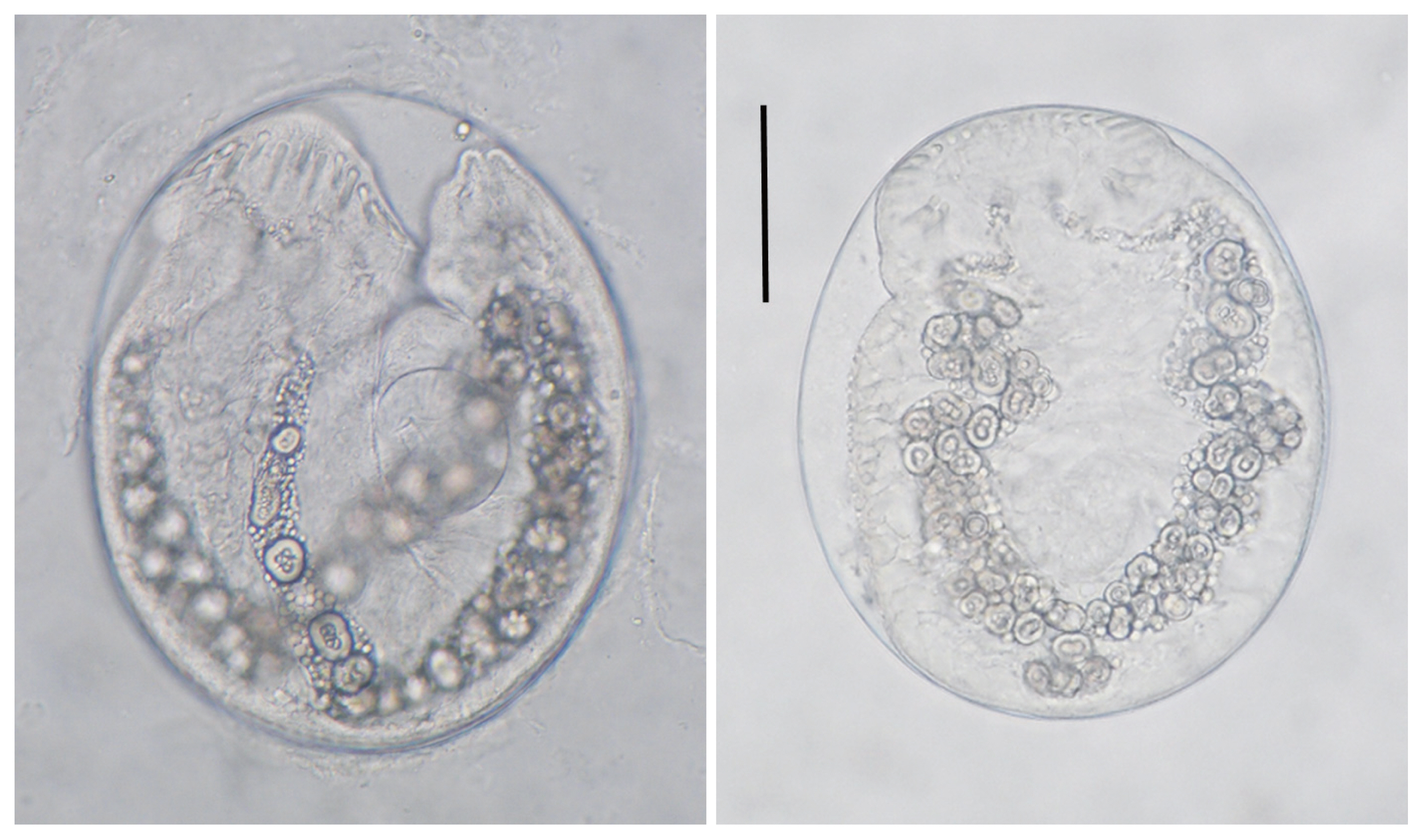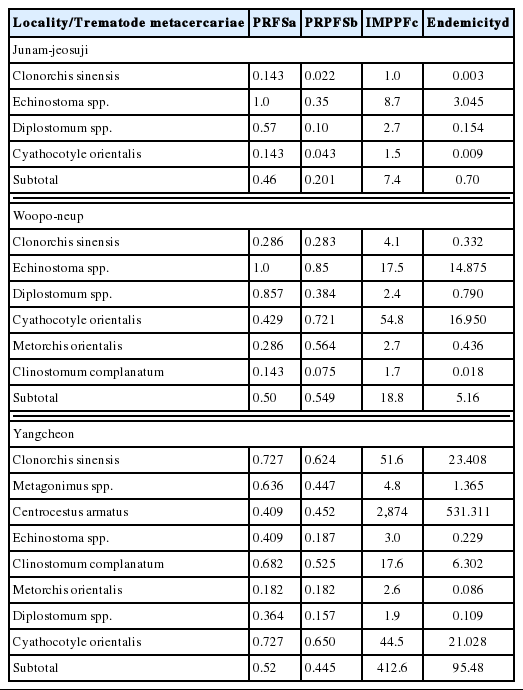Infections with Digenetic Trematode Metacercariae in Freshwater Fishes from Two Visiting Sites of Migratory Birds in Gyeongsangnam-do, Republic of Korea
Article information
Abstract
The infection status of digenetic trematode metacercariae (DTM) was investigated in fishes from 2 representative visiting sites of migratory birds in Gyeongsangnam-do, the Republic of Korea (Korea). A totaly 220 freshwater fishes (7 species) were collected from Junam-jeosuji (reservoir), and 127 fishes (7 species) were also collected from Woopo-neup (swamp) in June and October 2017. As the control group, total 312 fish (22 spp.) from Yangcheon in Sancheong-gun, Gyeongsangnam-do were also collected in June and October 2017. All fishes collected in 3 sites were examined with the artificial digestion method. In the fishes from Junam-jeosuji, more than 4 species, i.e., Clonorchis sinensis, Echinostoma spp., Diplostomum spp. and Cyathocotyle orientalis, of DTM were detected and their endemicy was very low, 0.70. More than 6 species, i.e., C. sinensis, Echinostoma spp., Metorchis orientalis, Clinostomum complanatum, Diplostomum spp. and C. orientalis, of DTM were found in the fishes from Woopo-neup, and their endemicy was low, 5.16. In the fishes from Yangcheon, more than 8 species, i.e., C. sinensis, Metagonimus spp., Centrocestus armatus, C. complanatum, C. orientalis, M. orientalis, Echinostoma spp., and Diplostomum spp., of DTM were detected, and their endemicity was relatively high, 95.48. The percentages of avian trematode metacercariae (ATM) were 99.6% and 94.7% in fishes from Junam-jeosuji and Woopo-neup whereas it was 74.1% in the control site, Yangcheon. The above findings suggested that migratory birds partly affect in endemicity of DTM in the fish in the 2 visiting sites in Gyeongsangnam-do, Korea.
INTRODUCTION
Numerous species of avian trematodes have been reported in the Republic of Korea (Korea). Most of them are the members of family Echinostomatidae, Microphallidae, and Gymnophallidae. More than 14 species of echinostomatid flukes, i.e., Acanthoparyphium marilae, A. tyosenense, Echinochasmus japonicus, Echinoparyphium recurvatum, Echinostoma gotoi, E. miyagawai, E. revolutum, Himasthla kusasigi, Patagifer bilobus, Petasiger neocomense, Saakotrema metatestis, Pegosomum bubulcum, Nephrostomum ramosum and Chaunocephalus ferox, were detected from the various species of bird in Korea [1–10]. Total 6 species of microphallid (Microphallus koreana, Gynaecotyla squatarolae, Maritrema jebuensis, M. obstipum, Endocotyle incana and Spelotrema pseudogonocotyla) [11–14], and 4 species of gymnophallid flukes (Gymnophalloides seoi, Gymnophallus macrostoma, Parvatrema duboisi and P. homoeotecnum) [15–17] were reported as avian trematodes in Korea. On the other hand, it has been known that several species of avian trematode, i.e., Centrocestus armatus, Cyathocotyle orientalis, Holostephanus nipponicus, Clinostomum complanatum, Metorchis orientalis, M. taiwanensis and Diplostomum spp., metacercariae are frequently detected in the freshwater fishes in Korea [18–21].
Junam-jeosuji (a reservoir in Dong-eup, Changwon-si) and Woopo-neup (a swamp in Changnyung-gun) in Gyeongsangnam-do, are famous as the visiting sites of miratory birds in Winter season. More than 20 species of migratory birds from China, Siberia and so on winter until late in March [22]. The specific ecological condition, such as the massive visiting of various migratory birds, may be affected the avian trematode fauna in 2 sites. On the other hand, many Korean workers have been investigated the infection status with digenetic trematode metacercariae (DTM) including Clonorchis sinensis in fishes from various ecological environments, such as river, stream, lake, pond, swamp and even coast, to estimate the DTM endemicities [18–21,23–29]. Most of these studies were performed on the specific trematode species related with human infections, such as C. sinensis, heterophyid including Metagonimus yokogawai and echinostomatid flukes, in Korea [23–29]. However, there have been not so many studies on the avian trematode metacercariae (ATM) in fishes from the visiting sites of migratory birds in Korea. Moreover, the infection status of DTM in fishes from Junam-jeosuji and Woopo-neup was surveyed in a long time ago [30–32]. Therefore, we are going to focus on the infection status of ATM in 2 representative visiting sites of migratory birds, Junam-jeosuji and Woopo-neup, with a comparison of that in control site, Yangcheon, in Gyeongsangnam-do, Korea.
MATERIALS AND METHODS
Main survey (fish collection) sites were Junam-jeosuji in Dong-eup (eup=town) (35.313588; 128.666354), Changwon-si (si=city), Gyeongsangnam-do (do=province), and Woopo-neup in Ibang-myeon (myeon=township) (35.566238; 128.408215), Changnyeong-gun (gun=county), Gyeongsangnam-do, Korea. Total 220 fishes (7 spp.) from Junam-jeosuji were examined in June and October 2017. Fish species (No. of fish) examined were Erythroculter erythropterus (52), Lepomis macrochirus (52), Hemiculter eigenmanni (46), Cyprinus carpio (26), Acanthorhodeus gracilis (20), Carassius auratus (12), Micropterus salmoides (12). A total of 127 fishes (7 spp.) from Woopo-neup were examined in October 2017. Fish species (No. of fish) examined were Pseudorasbora parva (40), L. macrochirus (28), C. auratus (20), E. erythropterus (16), M. salmoides (15), H. eigenmanni (6), C. carpio (2).
As the control group, total 312 fish (22 spp.) from Yangcheon in Saengbiryang-myeon (35.355960; 128.056635), Sancheong-gun, Gyeongsangnam-do were also examined in June and October 2017. Fish species (No. of fish) examined were M. salmoides (36), Acheilognathus yamatsutae (31), Acheilognathus majusculus (30), Zacco platypus (27), L. macrochirus (25), C. auratus (21), Zacco temminckii (20), A. gracilis (20), Zacco koreanus (20), Pseudogobio esocinus (15), Squalidus japonicus coreanus (15), Pungtungia herzi (12), Coreoperca herzi (9), Acheilognathus rhombeus (7), Hemibarbus labeo (6), Hemibarbus longirostris (5), Odontobutis platycephala (4), Squalidus gracilis majimae (3), Acheilognathus koreensis (2), Acanthorhodeus macropterus (2), Sarcocheilichthys nigripinnis morii (1), Sarcocheilichthys variegatus wakiyae (1).
All collected fishes with ice were transferred to the laboratory of the Department of Parasitology and Tropical Medicine, Gyeongsang National University College of Medicine, Jinju, Korea. After the identification of fish species, they were individually ground with a mortar. Each ground fish meat was mixed with artificial gastric juice and the mixture was incubated at 36°C for about 2 hr. The digested material was filtered with 1×1 mm of mesh and washed with 0.85% saline untill the supernatant is clear. The sediment was carefully examined under a stereomicroscope. Digenetic trematode metacercariae (DTM) except for 3 species, i.e., Metacercaria hasegawai, Exorchis oviformis and Pseudoexorchis major, were separately collected by the general features [33], and they were counted to get hold of infection rates (%) and intensities (No. of DTM per fish infected) by fish species.
The endemicity of DTM was calculated by the Positive Rate in Fish Species (PRFS: No. of fish species infected/Total No. of fish species examined)×the Positive Rate in Positive Fish Species (PRPFS: No. of positive fish/total No. of fish in positive fish species examined)×the Intensity of Metacercariae Per a Positive Fish (IMPPF: Total No. of metacercariae detected/total No. of positive fish). The endemicity of avian trematode metacercariae (ATM) was calculated by the endemicity of ATM/total endemicity of DTM by the surveyed site ×100. More than 7 species, i.e., C. armatus, C. complanatum, C. orientalis, M. orientalis, M. taiwanensis Echinostoma spp. and Diplostomum spp., of DTM were treated as the ATM in this study.
RESULTS
In fishes from Junam-jeosuji, more than 4 species, i.e., C. sinensis, Echinostoma spp., Diplostomum sp. and C. orientalis, of DTM were detected, and their infection status by the fish species is detailedly shown in Table 1. More than 6 species, i.e., C. sinensis, Echinostoma spp., Diplostomum spp., C. orientalis, M. orientalis and C. complanatum, of DTM were found in fishes from Woopo-neup, and their infection status by the fish species is detailedly designated in Table 2. Unidentified echinostomatid metacercariae were dominant and commonly detected in all 7 fish species from 2 survey sites. Most of them were elliptical, 138–210 (162)×103–150 (127) μm in size and had a head crown equipped with 27 collar spines including 4 end-group ones in each side like those of Isthmiophora hortensis (Fig. 1).

Infection status of trematode metacercariae by fish species caught from Junam-jeosuji (reservoir) in Changwon-si, Gyeongsangnam-do, Korea

Infection status of trematode metacercariae by fish species caught Woopo-neup (swamp) in Changnyung-gun, Gyeongsangnam-do, Korea

Two echinostomatid metacercariae detected in a false dace, Pseudorasbora parva, from Woopo-neup in Changnyeong-gun, Gyeongsangnam-do, Korea. They were elliptical, 138–210 (162)×103–150 (127) μm in size and had a head crown equipped with 27 collar spines including 4 end-group ones in each sides. Scale bar is 50 μm.
In fishes from Yangcheon (control site), more than 8 species, i.e., C. sinensis, Metagonimus spp., C. armatus, C. complanatum, C. orientalis, M. orientalis, Echinostoma spp., and Diplostomum spp., of DTM were detected, and their infection status by the fish species is detailedly revealed in Table 3.

Infection status of trematode metacercariae by fish species caught from Yangcheon (stream) in Sancheong-gun, Gyeongsangnam-do, Korea
The overall DTM endemicies were 0.70 and 5.16 in fishes from Junam-jeosuji and Woopo-neup, whereas it was 95.48 in the control site, Yangcheon. In Junam-jeosuji, the endemicity of Echinostoma spp. (3.045) was most high and those of remains were relatively very low. In Woopo-neup, the endemicities of C. orientalis (16.950) and Echinostoma spp. (14.875) was relatively high and those of remains were below 1.0. Whereas in Yangcheon, the endemicity of C. armatus (531.311) was very high, those of C. sinensis (23.408) and C. orientalis (21.028) were moderate levels and those of remains were relatively low. The endemicities with DTM by the surveyed localities are detailedly designated in Table 4. The percentages of ATM were 99.6% and 94.7% in fishes from Junam-jeosuji and Woopo-neup, whereas it was 74.1% in the control site, Yangcheon.
DISCUSSION
The number of fish species examined were not so enough to evaluate DTM infections in 2 survey sites in this study. Among 7 fish species (total No. of fish) examined in each surveyed sites, 6 ones, i.e., L. macrochirus (80), E. erythropterus (68), H. eigenmanni (52), C. auratus (32), C. carpio (28), and M. salmoides (27), were commonly investigated, and remain each one was A. gracilis (20) in Junam-jeosuji and P. parva (40) in Woopo-neup. Therefore, in this study, we examined total 347 fish in 8 species from 2 visiting sites of migratory birds and a total of 312 fish in 22 species from the control site, Yangcheon, in Sancheong-gun, Gyeongsangnam-do. The smaller number of fish species in the 2 main survey sites than in the control site is strongly suggested that the ecology for fish is not so good in 2 survey sites, Junam-jeosuji and Woopo-neup. The bad condition of fish ecology was revealed in the previous studies. Han et al. [30] examined total 7 fish species, P. parva (301), E. erythropterus (113), Rhodeus uyekii (44), Rhodeus ocellatus (9), Gnathopogon atromaculatus (=G. striatus) (6), C. carassius (=C. auratus) (2) and Acanthorhodeus taenianalis (=A. macropterus) (2), from Junam-jeosuji in 1992. Kong and Choi [31] investigated DTM infections in 8 fish species, G. atromaculatus (61), A. taenianalis (33), P. parva (29), C. carassius (22), Zacco platypus (20), Microphysogobio koreesis (19), R. uyekii (16) and Zacco temminckii (8), from Woopo-neup. Sohn and Choi [32] also examined on the infection status of DTM in 5 fish species, H. eigenmanni (45), P. parva (25), E. erythropterus (20), A. macropterus (20), and C. auratus (20), from Junam-jeosuji. The exotic predatory fish, L. macrochirus and M. salmoides, and the big-sized fish, E. erythropterus and H. eigenmanni, were dominant in this study. Whereas, all fish examined were the native fish species and P. parva and E. erythropterus were dominant in the previous studies [30–32].
In the calculating formula of DTM endemicity, PRFS (the positive rate in fish species) was originated without the consideration of host-specificity between trematode larvae (cercariae) and fish species. The list of fish host for each DTM has not been known yet in Korea except some human trematodes including C. sinensis. In this study, we evenly applied PRFS as a factor of all DTM endemicity regardless of the host-specificity. The DTM endemicity, PRFS×PRPFS×IMPPF, is thought to be the more reasonable index to compare the endemicities of individual trematode species and specific trematode groups in a certain survey site. Undoubtedly, it is not to be an absolute index, shows a kind of trend for DTM infections, and its standard is changeable according to the trematode species.
Among the 24 avian trematodes reported in Korea, microphallid and gymnophallid flukes have no possibility to infect via the consumption of freshwater fish. Microphallid flukes, i.e., M. koreana, G. squatarolae, M. jebuensis, M. obstipum, E. incana and S. pseudogonocotyla, are to be mainly infected with the eatings of crustacean intermediate hosts like crabs [11–14]. Gymnophallids, i.e., G. seoi, G. macrostoma, P. duboisi and P. homoeotecnum, are mainly infected in clam-eating birds [15–17]. However, echinostomatid ones are known to be infected with the consumption of fish and molluscs including snails [1–10]. In this study, unidentified echinostomatid metacercariae were dominantly detected in all fish species from 2 survey sites. They were elliptical, 162×127 μm in average size and morphologically very similar with those of I. hortensis. The metacercariae of I. hortensis previously reported were globular or elliptical, 143–165 (154) by 128–158 (144) μm in size, and have 27 collar spines including 4 end group ones in each side of the head crown [29]. However, most of echinostomatid metacercariae detected were inactive in the cyst wall, and then we could not obtain the adult worms from hamsters experimentally infected with them. Reason why the echinostomatid metacercariae are dominant in fishes from 2 survey sites should be clarified with the recovery and identification of adults in near future.
The metacercariae of C. sinensis (CsMc) were detected in only 2 fish species, P. parva and H. eigenmanni from the 2 main survey sites and their prevalence and intensity were very low in this study. Han et al. [30] found them in 2 fish species, G. atromaculatus and P. parva, from Junam-jeosuji, Kong and Choi [31] detected CsMc in 4 fish species, G. atromaculatus P. parva, M. koreensis and A. taenianalis, from Woopo-neup and Sohn and Choi [32] also found them in 4 fish species, H. eigenmanni, P. parva, E. erythropterus and A. macropterus, from Junam-jeosuji. In previous studies, there are some differences in prevalences and intensities of CsMc, but their endemicity is not so high in fishes from 2 survey sites.
Conclusively, it was confirmed by the present study that the proportions of ATM are higher in fishes from 2 visiting sites of migratory birds, Junam-jeosuji and Woopo-neup, in Gyeongsangnam-do, Korea. However, overall DTM endemicies were very low in fishes from 2 survey sites when we compared with that in fishes from the control site, Yangcheon. These findings partly suggested that the specific ecological condition, the massive visiting of migratory birds, is to be affected the endemicity of avian trematodes. However, some environmental factors, i.e., the bad fish ecology with agitating of exotic fish species like blue gill and large mouth bass, a long-lasting drought and a remarkable propagation of water plants, may be acted as the limited points in this study.
ACKNOWLEDGMENTS
This study was supported by a grant from Korea Association of Health Promotion (KAHP-2017: Survey on the effects of migratory bird in the infection status of trematode metacercariae in fish from Junam Reservoir). We thank Jung-A Kim and Hee-Joo Kim (Department of Parasitology and Tropical Medicine, Gyeongsang National University College of Medicine, Jinju, Korea), for their help in the examination of fish.
Notes
CONFLICT OF INTEREST
The authors declare no conflict of interest related to this study.
